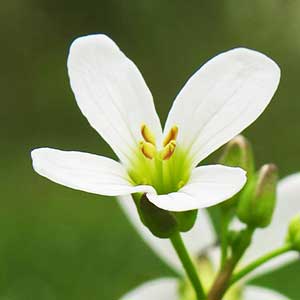Cardamine penduliflora
Brassicaceae tribe Cardamineae
wetlands bitter-cress, Willamette Valley bitter-cress
(tuberiform, fragile), 4–9(–11) mm diam., (fleshy).
erect or decumbent at base, unbranched, 2–6(–7.5) dm.
5–13-foliolate, (4–)10–18(–25) cm, leaflets petiolulate or subsessile;
petiole (3–)5–12(–17) cm;
lateral leaflets subsessile, blade similar to terminal, sometimes smaller;
terminal leaflet (petiolule 0.4–0.7 cm), blade oblong to elliptic or ovate, (0.4–)0.7–1.7(–2) cm, base cuneate or obtuse, margins entire or obscurely 3-lobed.
2–6, 5–11-foliolate, petiolate, leaflets petiolulate or sessile;
petiole 3–10 cm, base not auriculate;
lateral leaflets sessile, blade similar to terminal, smaller;
terminal leaflet (petiolule 0.5–1.5 cm), blade narrowly ovate or oblong to oblanceolate, 1.5–3.5 cm × 2–15 mm, margins entire or toothed to 3-lobed.
(rarely absent), usually petiolate, sometimes sessile;
blade (simple or compound), base auriculate or not, margins entire or dentate to pinnately lobed.
absent or simple.
ebracteate.
usually ebracteate (Selenia bracteate throughout), often elongated in fruit.
sepals oblong to ovate, 3.5–5 × 1.8–2.5 mm, lateral pair saccate basally;
petals white, obovate, 12–16 × 6–8 mm, (not clawed, apex rounded or subemarginate);
filaments: median pairs 6–7 mm, lateral pair 4–5 mm;
anthers oblong, 1.5–1.8 mm.
actinomorphic;
sepals erect to spreading or ascending, lateral pair seldom saccate basally;
petals white, yellow, pink, lilac, or purple, claw usually present, rarely absent, often distinct;
filaments unappendaged, not winged;
pollen 3-colpate.
ascending to divaricate, (10–)20–40(–60) mm.
linear, 2.5–4.5 cm × 1.4–2 mm;
ovules 12–24 per ovary;
style 4–6 mm.
silicles or siliques, dehiscent, unsegmented, terete, 4-angled, or latiseptate, rarely angustiseptate;
ovules 4–300[–numerous] per ovary;
style distinct or obsolete (absent in Subularia);
stigma usually entire.
brown, oblong, 1.8–2 × 1–1.5 mm.
biseriate or uniseriate;
cotyledons usually accumbent, sometimes incumbent.
Cardamine penduliflora
Brassicaceae tribe Cardamineae
Cardamine penduliflora is known from Douglas County north into Benton, Lane, Marion, Polk, and Yamhill counties.
(Discussion copyrighted by Flora of North America; reprinted with permission.)
Genera 12, species ca. 335 (10 genera, 85 species in the flora).
The assignment of Subularia to Cardamineae is provisional and based solely on morphology.
(Discussion copyrighted by Flora of North America; reprinted with permission.)


